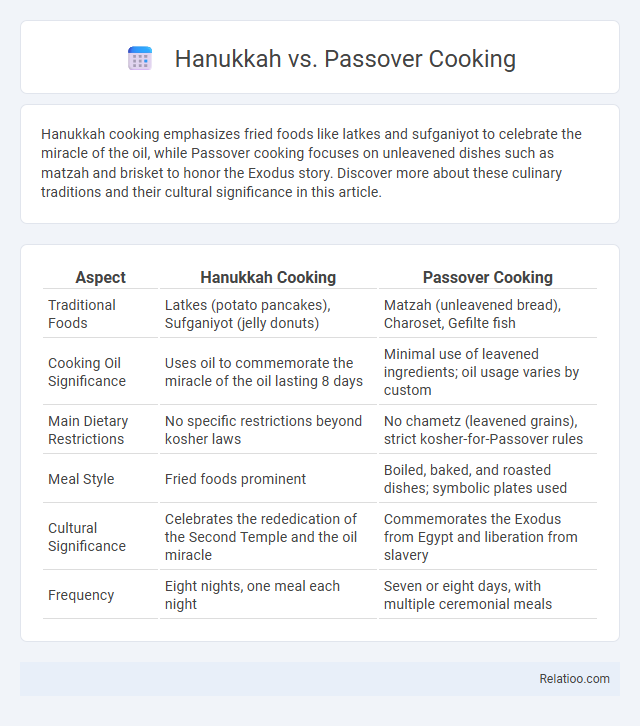Hanukkah cooking emphasizes fried foods like latkes and sufganiyot to celebrate the miracle of the oil, while Passover cooking focuses on unleavened dishes such as matzah and brisket to honor the Exodus story. Discover more about these culinary traditions and their cultural significance in this article.
Table of Comparison
| Aspect | Hanukkah Cooking | Passover Cooking |
|---|---|---|
| Traditional Foods | Latkes (potato pancakes), Sufganiyot (jelly donuts) | Matzah (unleavened bread), Charoset, Gefilte fish |
| Cooking Oil Significance | Uses oil to commemorate the miracle of the oil lasting 8 days | Minimal use of leavened ingredients; oil usage varies by custom |
| Main Dietary Restrictions | No specific restrictions beyond kosher laws | No chametz (leavened grains), strict kosher-for-Passover rules |
| Meal Style | Fried foods prominent | Boiled, baked, and roasted dishes; symbolic plates used |
| Cultural Significance | Celebrates the rededication of the Second Temple and the oil miracle | Commemorates the Exodus from Egypt and liberation from slavery |
| Frequency | Eight nights, one meal each night | Seven or eight days, with multiple ceremonial meals |
Overview: Hanukkah and Passover Culinary Traditions
Hanukkah cooking emphasizes oil-based dishes like latkes and sufganiyot to commemorate the miracle of the oil lasting eight days, while Passover culinary traditions focus on unleavened foods such as matzah and avoid chametz to observe the Exodus from Egypt. Your celebration will feature distinctive recipes that reflect historical and religious significance, with Hanukkah highlighting fried foods and Passover centered on specific dietary restrictions. Both holidays showcase unique flavors and cooking methods that connect families to their heritage and faith.
Symbolic Foods: Meaning on Each Holiday Table
Hanukkah cooking centers on foods fried in oil, such as latkes and sufganiyot, symbolizing the miracle of the oil that lasted eight days in the rededicated Temple. Passover cooking emphasizes unleavened foods like matzah, representing the Israelites' hasty exodus from Egypt without time for bread to rise, along with symbolic items on the Seder plate. Each holiday table uniquely uses these traditional foods to honor historical events and spiritual themes embedded in Jewish heritage.
Dietary Rules: Kosher Laws for Hanukkah and Passover
Hanukkah and Passover cooking both adhere to strict kosher laws, but your approach varies due to differing dietary restrictions. Hanukkah recipes emphasize frying in oil and using kosher ingredients, celebrating the oil miracle, while Passover strictly prohibits chametz--leavened grains--requiring you to avoid wheat, barley, rye, oats, and spelt unless unleavened. Both holidays require kosher certification, but Passover demands additional cleansing of utensils and exclusive Passover products to maintain ritual purity.
Iconic Dishes: Latkes vs. Matzo Ball Soup
Latkes, traditional Hanukkah potato pancakes, symbolize the miracle of the oil and are crispy, golden delights often served with sour cream or applesauce. Matzo ball soup, a staple during Passover, features light, fluffy dumplings made from matzo meal, reflecting the unleavened bread eaten during the festival. Both dishes hold deep cultural significance, highlighting the unique culinary traditions of Hanukkah and Passover celebrations.
Frying for Hanukkah, Baking for Passover
Hanukkah cooking centers on frying foods like latkes and sufganiyot to honor the miracle of the oil lasting eight days, making frying a symbolic and essential technique. Passover cooking relies heavily on baking unleavened goods such as matzah and kosher-for-Passover cakes, reflecting the need to avoid leavened products during the holiday. Your culinary preparations can emphasize frying techniques for Hanukkah and baking methods for Passover to capture the traditional flavors and rituals of each celebration.
Sweets and Desserts: Sufganiyot and Flourless Cakes
Sufganiyot, traditional jelly-filled doughnuts, are iconic Hanukkah sweets symbolizing the miracle of the oil and are typically fried to commemorate this event. Passover desserts focus on flourless cakes and other treats made without leavened flour, adhering to dietary restrictions during the holiday. When cooking for these celebrations, your choice between sufganiyot and flourless cakes reflects both cultural significance and adherence to religious dietary laws.
Ingredient Restrictions: Leavened vs. Unleavened
Hanukkah cooking emphasizes traditional fried foods like latkes and sufganiyot, which often include leavened ingredients such as flour and yeast, symbolizing the miracle of oil. Passover cooking strictly prohibits leavened products, favoring unleavened ingredients like matzah and specific grains, reflecting the Exodus narrative. The key distinction lies in Passover's dietary laws banning chametz, while Hanukkah recipes allow leavened foods without such restrictions.
Family Rituals: Cooking as a Holiday Activity
Hanukkah cooking centers on frying foods like latkes and sufganiyot, symbolizing the oil miracle and fostering family bonding through shared preparation. Passover cooking emphasizes unleavened dishes such as matzah and charoset, adhering to religious dietary laws that bring families together in purposeful activity. Your family's involvement in these holiday rituals transforms cooking into a meaningful, hands-on experience celebrating cultural heritage.
Regional Variations: Ashkenazi and Sephardic Influences
Hanukkah and Passover cooking reveal distinct regional variations shaped by Ashkenazi and Sephardic influences, with Ashkenazi traditions favoring potato latkes and matzah ball soup, while Sephardic cuisines emphasize fried fritters like bimuelos and rich dishes using herbs and spices. During Hanukkah, Sephardic recipes incorporate olive oil and Mediterranean ingredients, reflecting the festival's oil symbolism, contrasting with Ashkenazi reliance on dairy and root vegetables. Passover meals highlight Sephardic use of legumes and rice, banned in Ashkenazi customs, demonstrating diverse culinary adaptation based on historical and geographical contexts.
Modern Twists on Traditional Recipes
Modern twists on Hanukkah and Passover cooking reinvent traditional recipes by incorporating global flavors and contemporary techniques while respecting ritual dietary laws. Hanukkah menus often feature innovative takes on classic fried foods like latkes using sweet potatoes or adding spices such as za'atar, enhancing taste and texture. Passover dishes experiment with gluten-free grains like quinoa and novel ingredient pairings, reimagining staples like matzah ball soup and charoset for a modern palate.

Infographic: Hanukkah vs Passover Cooking
 relatioo.com
relatioo.com